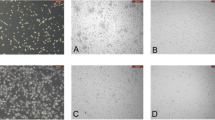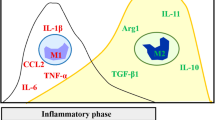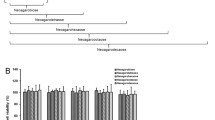Abstract
The high- and the low-molecular weight hyaluronic acids (HMW-HA and LMW-HA, respectively) showed different biological activities in inflammation. However, the role of LMW-HA in inflammatory response is controversial. In this study, we aimed to investigate the effect of bioactive hyaluronan (B-HA) on lipopolysaccharide (LPS)-induced inflammatory responses in human macrophages and mice. B-HA was produced from HA treated with glycosylated recombinant human hyaluronidase PH20. Human THP-1 cells were induced to differentiate into macrophages. THP-1-derived macrophages were treated with B-HA, LPS, or B-HA + LPS. The mRNA expression and the production of inflammatory cytokines were determined using quantitative real-time PCR and enzyme-linked immunosorbent assay. The phosphorylation levels of proteins in the nuclear factor-κB (NF-κB), mitogen-activated protein kinase (MAPK), and IRF-3 signaling pathways were measured using Western blot. The in vivo efficacy of B-HA was assessed in a mouse model of LPS-induced inflammation. Results showed that B-HA inhibited the expression of TNF-α, IL-6, IL-1, and IFN-β, and enhanced the expression of the antiinflammatory cytokine IL-10 in LPS-induced inflammatory responses in THP-1-derived macrophages and in vivo. B-HA significantly suppressed the phosphorylation of the TLR4 signaling pathway proteins p65, IKKα/β, IκBα, JNK1/2, ERK1/2, p38, and IRF-3. In conclusion, our results demonstrated that the B-HA attenuated the LPS-stimulated inflammatory response by inhibiting the activation of the TLR4 signaling pathway. B-HA could be a potential anti-inflammatory drug in the treatment of inflammatory disease.
Similar content being viewed by others
References
Lee JY, Spicer AP. Hyaluronan: a multifunctional, megaDalton, stealth molecule. Curr Opin Cell Biol 2000; 12(5): 581–586
Moore AR. Hyaluronan—a review of the recent patent literature. IDrugs 2000; 3(2): 198–201
Liang J, Jiang D, Noble PW. Hyaluronan as a therapeutic target in human diseases. Adv Drug Deliv Rev 2016; 97: 186–203
Hill DR, Rho HK, Kessler SP, Amin R, Homer CR, McDonald C, Cowman MK, de la Motte CA. Human milk hyaluronan enhances innate defense of the intestinal epithelium. J Biol Chem 2013; 288(40): 29090–29104
Jiang D, Liang J, Noble PW. Hyaluronan as an immune regulator in human diseases. Physiol Rev 2011; 91(1): 221–264
Noble PW. Hyaluronan and its catabolic products in tissue injury and repair. Matrix Biol 2002; 21(1): 25–29
Lennon FE, Singleton PA. Role of hyaluronan and hyaluronan-binding proteins in lung pathobiology. Am J Physiol Lung Cell Mol Physiol 2011; 301(2): L137–L147
Yamasaki K, Muto J, Taylor KR, Cogen AL, Audish D, Bertin J, Grant EP, Coyle AJ, Misaghi A, Hoffman HM, Gallo RL. NLRP3/ cryopyrin is necessary for interleukin-1β (IL-1β) release in response to hyaluronan, an endogenous trigger of inflammation in response to injury. J Biol Chem 2009; 284(19): 12762–12771
Campo GM, Avenoso A, Campo S, D’Ascola A, Nastasi G, Calatroni A. Small hyaluronan oligosaccharides induce inflammation by engaging both Toll-like-4 and CD44 receptors in human chondrocytes. Biochem Pharmacol 2010; 80(4): 480–490
Kim MY, Muto J, Gallo RL. Hyaluronic acid oligosaccharides suppress TLR3-dependent cytokine expression in a TLR4-dependent manner. PLoS One 2013; 8(8): e72421
Kawana H, Karaki H, Higashi M, Miyazaki M, Hilberg F, Kitagawa M, Harigaya K. CD44 suppresses TLR-mediated inflammation. J Immunol 2008; 180(6): 4235–4245
Kang DW, Jadin L, Nekoroski T, Drake FH, Zepeda ML. Recombinant human hyaluronidase PH20 (rHuPH20) facilitates subcutaneous infusions of large volumes of immunoglobulin in a swine model. Drug Deliv Transl Res 2012; 2(4): 254–264
Black KE, Collins SL, Hagan RS, Hamblin MJ, Chan-Li Y, Hallowell RW, Powell JD, Horton MR. Hyaluronan fragments induce IFNβ via a novel TLR4-TRIF-TBK1-IRF3-dependent pathway. J Inflamm (Lond) 2013; 10(1): 23
Scheibner KA, Lutz MA, Boodoo S, Fenton MJ, Powell JD, Horton MR. Hyaluronan fragments act as an endogenous danger signal by engaging TLR2. J Immunol 2006; 177(2): 1272–1281
Taylor KR, Yamasaki K, Radek KA, Di Nardo A, Goodarzi H, Golenbock D, Beutler B, Gallo RL. Recognition of hyaluronan released in sterile injury involves a unique receptor complex dependent on Toll-like receptor 4, CD44, and MD-2. J Biol Chem 2007; 282(25): 18265–18275
Kouvidi K, Berdiaki A, Nikitovic D, Katonis P, Afratis N, Hascall VC, Karamanos NK, Tzanakakis GN. Role of receptor for hyaluronic acid-mediated motility (RHAMM) in low molecular weight hyaluronan (LMWHA)-mediated fibrosarcoma cell adhesion. J Biol Chem 2011; 286(44): 38509–38520
Hotamisligil GS. Inflammation and metabolic disorders. Nature 2006; 444(7121): 860–867
Ross R. Atherosclerosis—an inflammatory disease. N Engl J Med 1999; 340(2): 115–126
Coussens LM, Werb Z. Inflammation and cancer. Nature 2002; 420(6917): 860–867
Schultze JL, Schmieder A, Goerdt S. Macrophage activation in human diseases. Semin Immunol 2015; 27(4): 249–256
Zhang X, Mosser DM. Macrophage activation by endogenous danger signals. J Pathol 2008; 214(2): 161–178
Wang H, Bloom O, Zhang M, Vishnubhakat JM, Ombrellino M, Che J, Frazier A, Yang H, Ivanova S, Borovikova L, Manogue KR, Faist E, Abraham E, Andersson J, Andersson U, Molina PE, Abumrad NN, Sama A, Tracey KJ. HMG-1 as a late mediator of endotoxin lethality in mice. Science 1999; 285(5425): 248–251
Lotze MT, Tracey KJ. High-mobility group box 1 protein (HMGB1): nuclear weapon in the immune arsenal. Nat Rev Immunol 2005; 5(4): 331–342
Akhter N, Hasan A, Shenouda S, Wilson A, Kochumon S, Ali S, Tuomilehto J, Sindhu S, Ahmad R. TLR4/MyD88-mediated CCL2 production by lipopolysaccharide (endotoxin): implications for metabolic inflammation. J Diabetes Metab Disord 2018; 17(1): 77–84
Turley EA, Noble PW, Bourguignon LY. Signaling properties of hyaluronan receptors. J Biol Chem 2002; 277(7): 4589–4592
Liang J, Jiang D, Griffith J, Yu S, Fan J, Zhao X, Bucala R, Noble PW. CD44 is a negative regulator of acute pulmonary inflammation and lipopolysaccharide-TLR signaling in mouse macrophages. J Immunol 2007; 178(4): 2469–2475
Terabe K, Ohashi Y, Tsuchiya S, Ishizuka S, Knudson CB, Knudson W. Chondroprotective effects of 4-methylumbelliferone and hyaluronan synthase-2 overexpression involve changes in chondrocyte energy metabolism. J Biol Chem 2019; 294(47): 17799–17817
Li Z, Potts EN, Piantadosi CA, Foster WM, Hollingsworth JW. Hyaluronan fragments contribute to the ozone-primed immune response to lipopolysaccharide. J Immunol 2010; 185(11): 6891–6898
De Nardo D. Toll-like receptors: activation, signalling and transcriptional modulation. Cytokine 2015; 74(2): 181–189
Guha M, Mackman N. LPS induction of gene expression in human monocytes. Cell Signal 2001; 13(2): 85–94
O’Neill LA, Bowie AG. The family of five: TIR-domain-containing adaptors in Toll-like receptor signalling. Nat Rev Immunol 2007; 7(5): 353–364
Thada S, Valluri VL, Gaddam SL. Influence of Toll-like receptor gene polymorphisms to tuberculosis susceptibility in humans. Scand J Immunol 2013; 78(3): 221–229
Park EK, Jung HS, Yang HI, Yoo MC, Kim C, Kim KS. Optimized THP-1 differentiation is required for the detection of responses to weak stimuli. Inflamm Res 2007; 56(1): 45–50
Wu Y, Zhu X, Li N, Chen T, Yang M, Yao M, Liu X, Jin B, Wang X, Cao X. CMRF-35-like molecule 3 preferentially promotes TLR9-triggered proinflammatory cytokine production in macrophages by enhancing TNF receptor-associated factor 6 ubiquitination. J Immunol 2011; 187(9): 4881–4889
Kolar SL, Kyme P, Tseng CW, Soliman A, Kaplan A, Liang J, Nizet V, Jiang D, Murali R, Arditi M, Underhill DM, Liu GY. Group B streptococcus evades host immunity by degrading hyaluronan. Cell Host Microbe 2015; 18(6): 694–704
Medzhitov R. Origin and physiological roles of inflammation. Nature 2008; 454(7203): 428–435
Hasan A, Akhter N, Al-Roub A, Thomas R, Kochumon S, Wilson A, Koshy M, Al-Ozairi E, Al-Mulla F, Ahmad R. TNF-α in combination with palmitate enhances IL-8 production via the MyD88-independent TLR4 signaling pathway: potential relevance to metabolic inflammation. Int J Mol Sci 2019; 20(17): E4112
Cinel I, Opal SM. Molecular biology of inflammation and sepsis: a primer. Crit Care Med 2009; 37(1): 291–304
Avila M, Martinez-Juarez A, Ibarra-Sanchez A, Gonzalez-Espinosa C. Lyn kinase controls TLR4-dependent IKK and MAPK activation modulating the activity of TRAF-6/TAK-1 protein complex in mast cells. Innate Immun 2012; 18(4): 648–660
Sindhu S, Akhter N, Kochumon S, Thomas R, Wilson A, Shenouda S, Tuomilehto J, Ahmad R. Increased expression of the innate immune receptor TLR10 in obesity and type-2 diabetes: association with ROS-mediated oxidative stress. Cell Physiol Biochem 2018; 45(2): 572–590
Lacatus M. Innate immunity in surgical patients. Chirurgia (Bucur) 2013; 108(1): 18–25
Cai B, Wang M, Zhu X, Xu J, Zheng W, Zhang Y, Zheng F, Feng Z, Zhu J. The Fab fragment of a humanized anti-Toll like receptor 4 (TLR4) monoclonal antibody reduces the lipopolysaccharide response via TLR4 in mouse macrophage. Int J Mol Sci 2015; 16(10): 25502–25515
Kochumon S, Al-Rashed F, Abu-Farha M, Devarajan S, Tuomilehto J, Ahmad R. Adipose tissue expression of CCL19 chemokine is positively associated with insulin resistance. Diabetes Metab Res Rev 2019; 35(2): e3087
Sindhu S, Kochumon S, Shenouda S, Wilson A, Al-Mulla F, Ahmad R. The cooperative induction of CCL4 in human monocytic cells by TNF-α and palmitate requires MyD88 and involves MAPK/NF-κB signaling pathways. Int J Mol Sci 2019; 20(18): E4658
Kochumon S, Wilson A, Chandy B, Shenouda S, Tuomilehto J, Sindhu S, Ahmad R. Palmitate activates CCL4 expression in human monocytic cells via TLR4/MyD88 dependent activation of NF-κB/ MAPK/ PI3K signaling systems. Cell Physiol Biochem 2018; 46(3): 953–964
Sindhu S, Al-Roub A, Koshy M, Thomas R, Ahmad R. Palmitate-induced MMP-9 expression in the human monocytic cells is mediated through the TLR4-MyD88 dependent mechanism. Cell Physiol Biochem 2016; 39(3): 889–900
Ahmad R, Al-Roub A, Kochumon S, Akther N, Thomas R, Kumari M, Koshy MS, Tiss A, Hannun YA, Tuomilehto J, Sindhu S, Rosen ED. The synergy between palmitate and TNF-α for CCL2 production is dependent on the TRIF/IRF3 pathway: implications for metabolic inflammation. J Immunol 2018; 200(10): 3599–3611
Kawai T, Akira S. TLR signaling. Semin Immunol 2007; 19(1): 24–32
Xu C, Chen G, Yang W, Xu Y, Xu Y, Huang X, Liu J, Feng Y, Xu Y, Liu B. Hyaluronan ameliorates LPS-induced acute lung injury in mice via Toll-like receptor (TLR) 4-dependent signaling pathways. Int Immunopharmacol 2015; 28(2): 1050–1058
Akashi S, Saitoh S, Wakabayashi Y, Kikuchi T, Takamura N, Nagai Y, Kusumoto Y, Fukase K, Kusumoto S, Adachi Y, Kosugi A, Miyake K. Lipopolysaccharide interaction with cell surface Toll-like receptor 4-MD-2: higher affinity than that with MD-2 or CD14. J Exp Med 2003; 198(7): 1035–1042
Saraiva M, O’Garra A. The regulation of IL-10 production by immune cells. Nat Rev Immunol 2010; 10(3): 170–181
Moore KW, de Waal Malefyt R, Coffman RL, O’Garra A. Interleukin-10 and the interleukin-10 receptor. Annu Rev Immunol 2001; 19(1): 683–765
Acknowledgements
We would like to thank Editage for English language editing and Publication Support. This work was supported by grants from the Chinese National Twelfth Five-year Plan Project (No. 2013ZX09J-13110-05B, MW) and the Social Development Project of Jiangsu Province (No. BE2015651, JZ). The funders had no role in study design, data collection and analysis, decision to publish, or preparation of the manuscript.
Author information
Authors and Affiliations
Corresponding authors
Additional information
Compliance with ethics guidelines
Na You, Sasa Chu, Binggang Cai, Youfang Gao, Mizhou Hui, Jin Zhu, and Maorong Wang declare that they have no conflict of interest. All institutional and national guidelines for the care and use of laboratory animals were followed.
Rights and permissions
About this article
Cite this article
You, N., Chu, S., Cai, B. et al. Bioactive hyaluronic acid fragments inhibit lipopolysaccharide-induced inflammatory responses via the Toll-like receptor 4 signaling pathway. Front. Med. 15, 292–301 (2021). https://doi.org/10.1007/s11684-020-0806-5
Received:
Accepted:
Published:
Issue Date:
DOI: https://doi.org/10.1007/s11684-020-0806-5




